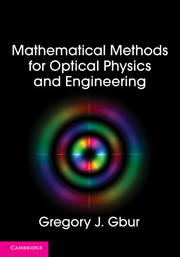Book contents
- Frontmatter
- Contents
- Preface
- 1 Vector algebra
- 2 Vector calculus
- 3 Vector calculus in curvilinear coordinate systems
- 4 Matrices and linear algebra
- 5 Advanced matrix techniques and tensors
- 6 Distributions
- 7 Infinite series
- 8 Fourier series
- 9 Complex analysis
- 10 Advanced complex analysis
- 11 Fourier transforms
- 12 Other integral transforms
- 13 Discrete transforms
- 14 Ordinary differential equations
- 15 Partial differential equations
- 16 Bessel functions
- 17 Legendre functions and spherical harmonics
- 18 Orthogonal functions
- 19 Green's functions
- 20 The calculus of variations
- 21 Asymptotic techniques
- Appendix A The gamma function
- Appendix B Hypergeometric functions
- References
- Index
8 - Fourier series
Published online by Cambridge University Press: 05 June 2012
- Frontmatter
- Contents
- Preface
- 1 Vector algebra
- 2 Vector calculus
- 3 Vector calculus in curvilinear coordinate systems
- 4 Matrices and linear algebra
- 5 Advanced matrix techniques and tensors
- 6 Distributions
- 7 Infinite series
- 8 Fourier series
- 9 Complex analysis
- 10 Advanced complex analysis
- 11 Fourier transforms
- 12 Other integral transforms
- 13 Discrete transforms
- 14 Ordinary differential equations
- 15 Partial differential equations
- 16 Bessel functions
- 17 Legendre functions and spherical harmonics
- 18 Orthogonal functions
- 19 Green's functions
- 20 The calculus of variations
- 21 Asymptotic techniques
- Appendix A The gamma function
- Appendix B Hypergeometric functions
- References
- Index
Summary
Introduction: diffraction gratings
When a polychromatic beam of light is shined upon a translucent planar material etched with a periodic pattern known as a diffraction grating, the different colors of the beam of light propagate in different directions. Such a diffraction grating can be used as a monochromator of light or as a spectrometer, as schematically illustrated in Fig. 8.1.
The physics of a diffraction grating can be understood by a simple interference argument: we suppose that light of wavelength λ is normally incident upon a thin opaque screen containing a large number of periodically arranged narrow apertures (slits) separated by a distance Δ. Because the light is normally incident upon the grating, the phase of the field is the same within each aperture. Each aperture produces a spherical wave, and we consider the overlap of the fields from two such elements in a direction θ from the normal to the surface; this is illustrated in Fig. 8.2.
As can be seen from the picture, the wave emanating from aperture 2 has to travel a distance Δsin θ farther than the wave emanating from aperture 1. This translates to a phase difference between the two waves of kΔsin θ, where k = 2π/λ is the wavenumber of the light.
- Type
- Chapter
- Information
- Mathematical Methods for Optical Physics and Engineering , pp. 230 - 251Publisher: Cambridge University PressPrint publication year: 2011



